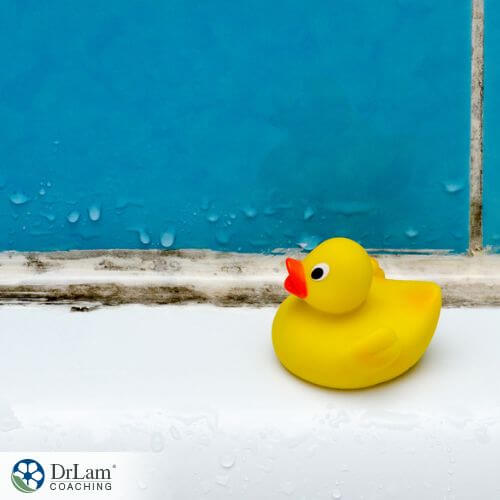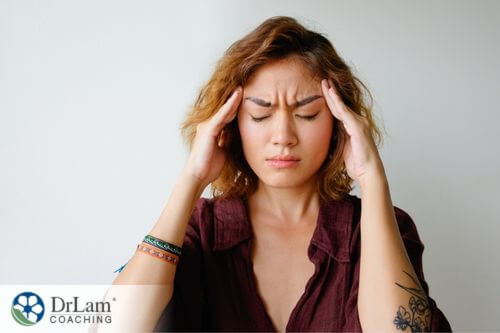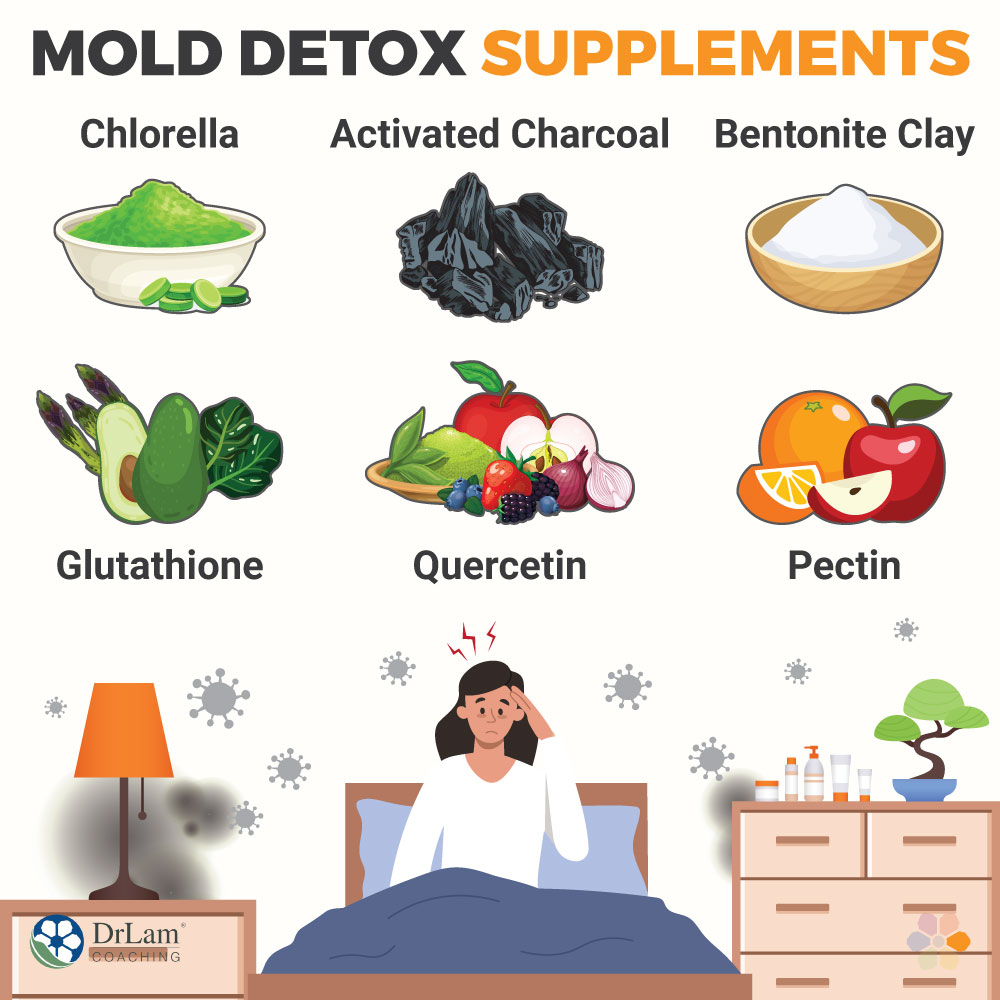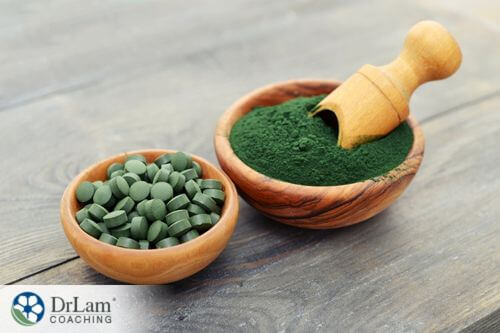The thought of mold puts most of us on edge, whether it's on food, in your shower, or in your body. But we are all going to encounter mold at some point. And the question becomes, how dangerous is mold in your body, and do you need to do a mold detox? And if so, when, and how? But before we get to that, we first need to understand a little more about mold and what it does.
 The truth is you do not need to panic at the first sign of mold. Mold is not a sign that you do not clean properly or that there is necessarily something wrong with your home. Mold tends to make its way into homes during warm, wet, and humid conditions. So, the ideal breeding places, such as in your bathroom or under the kitchen sink, are places you should keep an eye on to stop the spread as soon as it is detected. But keep in mind that mold happens in all homes.
The truth is you do not need to panic at the first sign of mold. Mold is not a sign that you do not clean properly or that there is necessarily something wrong with your home. Mold tends to make its way into homes during warm, wet, and humid conditions. So, the ideal breeding places, such as in your bathroom or under the kitchen sink, are places you should keep an eye on to stop the spread as soon as it is detected. But keep in mind that mold happens in all homes.
As for its effect on your health, most researchers do not believe that mold toxicity is something that affects everyone. Rather, only certain people are at risk. And we will take a look at these elevated risk scenarios. For most people, however, the chances that you may need a mold detox are relatively slim if you are healthy with no underlying risk factors.
Mold is a fungus that, in nature, grows on damp, decaying matter. Think in terms of mushrooms. Mushrooms are also fungi. They spread through spores. We find these spores everywhere. You cannot see them. They are tiny and cling to anything. You may even have some on your right now without knowing it. You even breathe them in. And generally speaking, they do not harm you in any way.
By the time you see a mold infestation, you are dealing with a colony that has formed and, if left unaddressed, may form spores, and spread throughout your home, seeking out dark, damp areas to further procreate. While these spores do not necessarily harm you, they do tend to spread.
There are over 100,000 species of mold. Of these, only about eighty, in total, may cause harm to humans. Some of the most common types of molds found in the home include black mold (also known as Stachybotrys chartarum), Fusarium, Rhizopus, Cladosporium, and Aspergillus.
But not all molds are bad. The antibiotic penicillin, for example, is made from Penicillium mold.
So why did mold get such a bad name?
Mold gives off two types of toxins. These are called mycotoxins and volatile organic compounds. You can both inhale and/or swallow these toxins.
For mold to become a problem, it would mean swallowing or inhaling large quantities in healthy people. The mold could then start forming new colonies inside the body. At the same time, the mold would also be producing toxins inside the body. Chronic inflammatory response syndrome is one such health issue associated with mold toxicity.
In this situation, a mold detox may help rid your body of mold and its associated toxins.
The symptoms of mold toxicity are diverse. And this can mean that healthcare professionals fail to identify mold toxicity as the cause of your symptoms. Mold spores tend to create an inflammatory response in your body. If left unchecked, it may lead to serious health issues, many of which we commonly find in those suffering from adrenal fatigue.
 You may need to consider a mold detox if you experience:
You may need to consider a mold detox if you experience:
If you have these symptoms, it is a good idea to see your healthcare professional to rule out other problems and get advice on the best mold detox procedures for you.
Chronic stress, a common condition in many people in our culture, can interfere with your body's ability to detoxify mold naturally. Your NeuroEndoMetabolic (NEM) stress response and Detoxification Circuit are largely responsible for your body’s ability to deal with stress. Your NEM stress response, governed by the Hypothalamic-Pituitary-Adrenal (HPA) axis, releases hormones to react when stress occurs. Your Detoxification Circuit, including the liver and interstitium, is responsible for getting rid of any toxins present. Long-term stress can create an overload of toxins and make it more difficult for your Detoxification Circuit to work properly.
An unchecked buildup of toxins, such as the case with mold toxicity, may also contribute to, or cause Detoxification Circuit dysfunction. When this happens, you may see a variety of symptoms that include:
This happens because your immune system picks up the presence of any foreign substances in your body. It may initiate an inflammatory response. This is good, since it is a sign that your immune system is working to get rid of these pathogens. However, if the cause of the inflammatory response persists, you may experience a reactive metabolite overload that could lead to worsening symptoms that point toward a Detoxification System dysfunction.
If suffering from mold toxicity, a mold detox may help with this issue as will supplying adrenal support.
If left unabated, mold can cause damage to your home, depending on the type of mold found. However, while you often hear of black mold and the damage it can cause to homes, the color of mold does not indicate its possible health risk. Mold typically comes in three categories:
So, while mold, for most people, is a nuisance that may not cause much harm, in others, it could cause the worsening of existing health issues or a flare-up of an existing condition. Furthermore, even if healthy, if you show symptoms similar to airborne allergy symptoms, please consult your healthcare professional. Mold may cause these symptoms, and you may need a mold detox to help your healing process.

Addressing the issue may involve a mold detox, although it works best if you incorporate other changes into your approach as well.
Many supplements aid your body’s detoxification process. Some of these include the following:
 These algae help your detoxification process because they bind to toxins and heavy metals in your digestive tract. The bound toxins pass through your digestive tract and do not end up in your bloodstream. It also boosts your immune health and does not remove essential nutrients from your body, which is a problem with many detoxifiers.
These algae help your detoxification process because they bind to toxins and heavy metals in your digestive tract. The bound toxins pass through your digestive tract and do not end up in your bloodstream. It also boosts your immune health and does not remove essential nutrients from your body, which is a problem with many detoxifiers.
Activated charcoal, unlike chlorella, binds to anything. It binds not only to toxins, but to vitamins, minerals, and even medications. One should ideally only use activated charcoal during an acute situation and usually with the guidance of a healthcare professional. It should be taken on an empty stomach one to two hours away from food or medications or supplements for best binding ability. Beware of constipation also.
This clay comes from volcanic ash. It absorbs toxins and other harmful elements while providing your body with many minerals. These include magnesium calcium, potassium, and iron. The clay has both antibacterial and antiviral properties. It should be taken on an empty stomach one to two hours away from food or medications or supplements for best binding ability. The powder is also very dry and can cause constipation so make sure to drink plenty of water.
This antioxidant is naturally made in your liver, one of the organs forming part of your detoxification system. Many people with mold toxicity have low glutathione levels. You can find glutathione in supplement form. Many foods like asparagus, avocado, and spinach also have high concentrations of this powerful antioxidant.
Quercetin is another natural antioxidant supplement. Foods rich in quercetin include green tea, berries, onions, and apples. Besides strong antioxidant properties, a quercetin supplement also has strong anti-inflammatory properties.
You can use pectin as a supplement as it contains fiber and is a good binder. It is also abundant in natural sources including citrus fruits and apples. It helps get rid of any biotoxins in your gastrointestinal tract. It can, however, cause cramps, gas, and diarrhea in some people.
As with most health issues, your diet can play a huge role in protecting you from mold-related health issues.
The idea behind a mold detox diet is to exclude things that encourage fungal growth, like sugar, white flour, or processed foods.
Instead, structure your diet to include many of the following:
You should also, during this time, avoid foods made using mold like cheese, mushrooms, fermented foods, and alcoholic beverages.
As for fruits, be aware that some may have relatively high glucose concentrations. The best fruit choices while on a mold detox diet include citrus fruits, berries, avocado, watermelon, and cantaloupe.
 Your skin is not only your largest organ. It also forms an important part of your Detoxification Circuit. You sweat during a fever, for example, as a way of getting rid of toxins. Sweating also helps with body temperature regulation and forms part of your anti-inflammatory response.
Your skin is not only your largest organ. It also forms an important part of your Detoxification Circuit. You sweat during a fever, for example, as a way of getting rid of toxins. Sweating also helps with body temperature regulation and forms part of your anti-inflammatory response.
You can sit in a sauna to sweat or combine it with healthy exercise. Good exercise choices with a reduced risk of damage to your body include dancing, yoga, Pilates, tai chi, walking, biking, or even gardening. Swimming is another excellent choice. You will still sweat even though you do not know it. You could also consider making use of an ozone detox chamber. Not only will you sweat, but the ozone will help get rid of fungi, parasites, bacteria, and viruses.
Cleaning, or detoxing your home, not only gets rid of possible mold infestation but it also gives you a great full-body workout as well. This is important because mold spores may be present on various surfaces of your home. You only see the presence of mold once a colony has been established. So, by cleaning, you may get rid of mold spores before they have had the chance to multiply. This also helps reduce potential allergens to aggravate symptoms.
A health issue arising from stress can make you more vulnerable to mold symptoms, and vice versa. Prolonged stress can negatively influence your health due to the NEM response going into overdrive. By relaxing, however, you can help your NEM response slow down and provide your body with much-needed adrenal support. Relaxation techniques to consider:
Do anything that allows you to disconnect from the world around you. In other words, be selfish and take some ‘me’ time.
While you do not need to get flustered at the first sign of mold in your home, do be aware that, for some people, mold can have a health impact. Getting rid of it should be a priority, especially if someone in your home has hay fever or a compromised immune system.
If you decide to use supplements to help with your mold detox, please do so with the advice of a healthcare practitioner. They are best able to determine the benefits, dosage, and suitability.
If you suffer from mold toxicity and want to do a mold detox, here are a few things that can help:
If you would like to know more about how to do a mold detox or how mold symptoms might interact with stress, the team at Dr. Lam Coaching can help. We offer a free** no-obligation phone consultation at +1 (626) 571-1234 where we will privately discuss your symptoms and options. You can also send us a question through our Ask The Doctor system by clicking here.
Anything that rids our bodies of pathogens and toxins supports adrenal health. Mold toxicity adds stress to your body. If suffering from adrenal fatigue, it could add to your adrenal load and bring about an adrenal crash. By reducing toxins, a mold detox can help support adrenal health.
